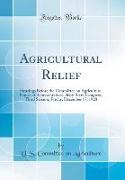- Start
- Agricultural Relief
Agricultural Relief
Angebote / Angebote:
Excerpt from Agricultural Relief: Hearings Before the Committee on Agriculture, House of Representatives, Sixty-Sixth Congress, Third Session, Friday, December 17, 1920In addition to the general market conditions, we have had this to contend against, in the Northwest particularly, in that great group of States known as the Rocky Mountain Range States. In the winter of 1918 - 19 we had no snow in the mountains up there. As you know, our crops are raised in the West through irrigation. That drought through the winter was something unheard of in the Rocky Moun tain regions. You could go out in the Yellowstone Park all winter long and, where there is usually 4 to 6 feet of snow, there was practi cally none. The result of that lack of snawfall was that the big irri gation streams out there dried up. In the Snake River - which is the greatest irrigation stream of the United States and one of the great est of the world, not excepting the Nile itself - the water got so low last fall that the women and children in the city of Idaho Falls, where ordinarily, when the circuses would come to town, they would turn their elephants out and their hippopotamuses out and let them swim in the river - that river got so low that the women and children walked across last year, just so they would be able to say they had done so in after years. As a result of that there was a 50 per cent loss in the hay crop and in crops of all kinds. That drought continued all during that summer. There was not one drop of rain in the entire Rocky Mountain Range from the beginning of spring until in Sep tember. That meant very poor liquidation, that meant lambs were 20 per cent to 25 per cent underweight when they went to market, and that meant 30 to 35 per cent depreciation in quality. That was also true of the cattle, so that when they went to market in the fall they were all feeders: there was no fat stuff, but cattle that were of verv indifferent and very poor quality.That resulted. As I say, in very poor liquidation, thev got very small returns. They might have stood that. That was all.right, we meet those things occasionally, but never so severe. But, strange to say. In October all the moisture that failed to fall before began to fall, and in October we had winter with snow falling 2 feet deep all over that country: with half a crop of hay and going in on feed three months ahead of time. That winter continued on until the following May. The net result of that condition was an increase of from 500 to 700 per cent in the feed bill. Our hay that normally costs us from $4 to $6 a ton, at the maximum, went up to $20 and $30 a ton, and, before spring, some of them were paying as high as $40 to $60 a ton for hay. Now the live-stock man, cattle and sheep, had to take his choice either to lose his herds through starvation or to buy hay at these prices. To pay these bills they went to the banks and loan com panies and executed chattel mortgages on their sheep and cattle in order to get money to pay these extravagant costs.About the PublisherForgotten Books publishes hundreds of thousands of rare and classic books. Find more at www.forgottenbooks.comThis book is a reproduction of an important historical work. Forgotten Books uses state-of-the-art technology to digitally reconstruct the work, preserving the original format whilst repairing imperfections present in the aged copy. In rare cases, an imperfection in the original, such as a blemish or missing page, may be replicated in our edition. We do, however, repair the vast majority of imperfections successfully, any imperfections that remain are intentionally left to preserve the state of such historical works.
Folgt in ca. 10 Arbeitstagen
